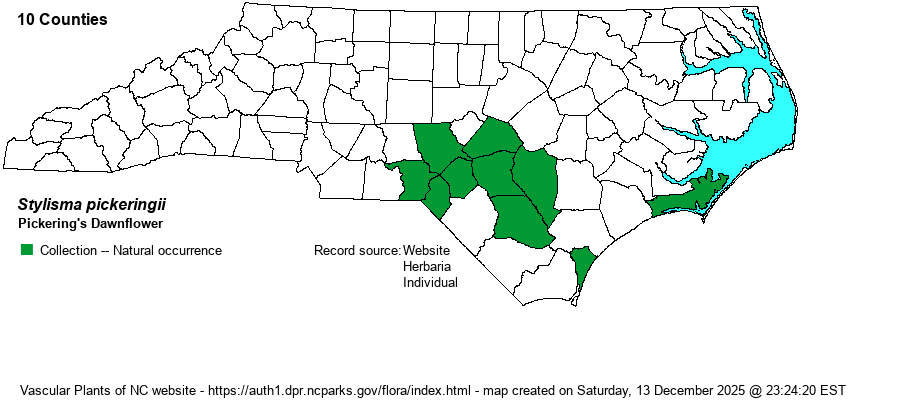| Author | (Torrey ex M.A. Curtis) A. Gray | |
| Distribution | Primarily in the Sandhills region, but does range sparingly eastward to a few coastal counties.
This is a very localized species, occurring in NJ, NC to TX, and then north to IA and IL. Absent in MD, DE, VA, FL, TN, and KY. | |
| Abundance | Fairly common at Fort Bragg and in the Sandhills Game Land, at least locally, but rare to uncommon elsewhere in the Sandhills region. Very rare and local east to Carteret and New Hanover counties. This is a State Special Concern species. | |
| Habitat | Though this species occurs in sandy soil, as do most other Stylisma species, it favors deep sands of Carolina Bay sand rims, xeric oak sandhills with bare sand, and other sandy barrens such as riverside sand deposits. In much of Fort Bragg and the Sandhills Game Land, it grows on recently bulldozed roadsides where there is very little competition. |
| Phenology | Blooms from June to August, and fruits shortly after flowering. | |
| Identification | This is a slender herbaceous vine growing to 3-4 feet long on average, freely branched at the base, sprawling in many directions. It typically crawls along the ground and does not climb or twine on vegetation. The alternate leaves are fairly close together, strongly or stiffly erect, about 2 inches long but needle-like and barely 1/10-inch wide. The axillary flowers are like most others in the genus, being on 1-inch long pedicels, white, and with a funnel shape, about 3/4-inch long and across. In this species, there are so many erect "needles" on stems that grow in many directions that the plant looks like no other in the state. | |
| Taxonomic Comments | There are several varieties for this species, and it is the nominate one -- var. pickeringii -- that is present in NC. The Stylisma species were formerly included in Bonamia.
| |
| Other Common Name(s) | None | |
| State Rank | S3 | |
| Global Rank | G4 | |
| State Status | [SC-V] | |
| US Status | | |
| USACE-agcp | FAC link |
| USACE-emp | FAC link |

